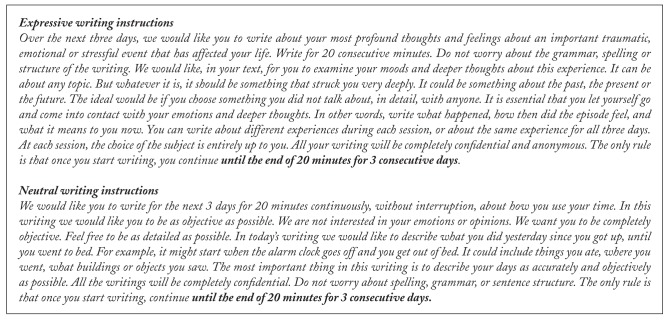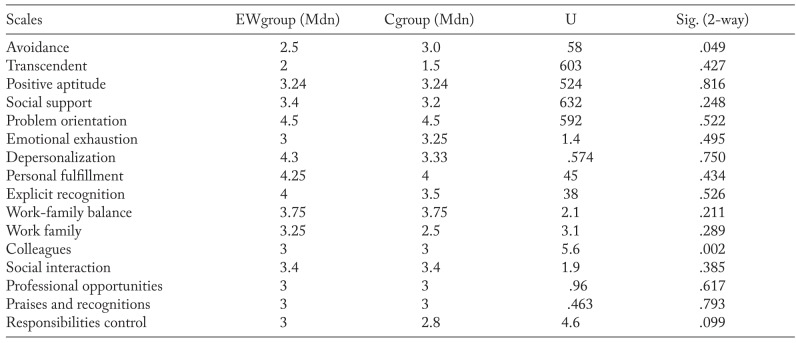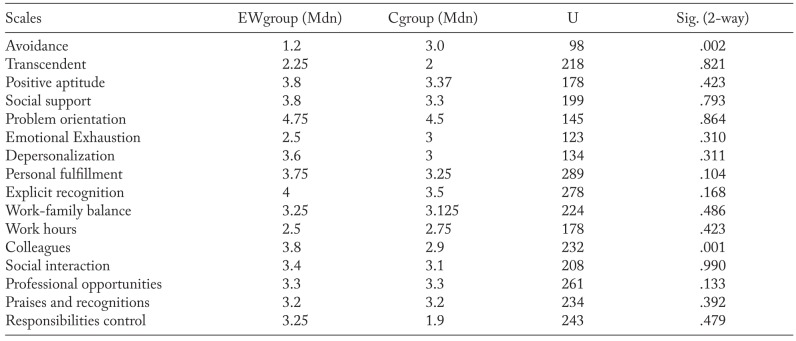Abstract
Background and aims: From a previous study (1) was highlighted that Expressive writing is an important strategy for preventing and managing the effects of compassion fatigue (2). It helps educate caregivers in recognising these feelings and providing them with a “space” and a time for their reflection. This, in turn, results in significant positive repercussions on the quality of service, reducing burnout risk, implementing coping strategies, and increasing perceived work satisfaction. Reflecting occasionally in writing about ambiguous and emotionally charged situations helps in many ways: it facilitates clarification and problem-solving, and makes one more spontaneous and present in social situations, more in tune with others and available to interact. People begin to interact differently with others and see themselves in a new light after writing about an emotional subject. The objective of thi study is ascertain and confirm the results of the previous study using a reduced methodological approach. Infact, the difference from the previous research is the use of only two expressive writing sessions. Methods: A comparison was made between the expressive writing and neutral writing of two randomized groups of health care professionals of palliative care. They were evaluated pre- and post-intervention using several scales and an ad hoc questionnaire. Results: After analyzing the texts, this study confirm previous results, using only two sessions.
Keywords: coping, emotions, expressive writing, working satisfaction
Background
From a previous study (1) it was highlighted that Expressive Writing (EW) is an important instrument to improve individual strategies for preventing and managing the effects of compassion fatigue (2). It helps educate caregivers in recognizing these feelings and providing them with a “space” and a time for their reflection. This, in turn, results in significant positive repercussions on the quality of service, reducing burnout risk, implementing coping strategies, and increasing perceived work satisfaction (1-6). Reflecting occasionally in writing about ambiguous and emotionally charged situations helps in many ways: It facilitates clarification and problem-solving, and makes one more spontaneous and present in social situations, more in tune with others and available to interact. People begin to interact differently with others and see themselves in a new light after writing about an emotional subject.
The interventions of EW in literature show a differentiation in the methodological structure. The writing methodology includes time and numbers of writing sessions.
In the meta-analysis of Smith (7) we notice that “...the numbers of the writing sessions and the length of each session do not influence the effects of the technique. We obtained positive results letting patients write from 3 to 6 days and for a period that varies from 15 to 20 minutes for each session...” and Smyth concludes that “...writing once per week instead of 3 or 4 times during the following days increases the effects in the set of variables took into account in the different works. This effect depending on the interval among sessions could suggest the need of a longer period of time to allow the processing of what was written” (8).
Another meta-analysis (4) analyzed studies where participants were asked to write for 20 minutes per 3 o 4 days but also once or twice per week per several weeks taking into account few other variables but nobody has ever experimented a shorter writing program. A further study (9), led on patients affected by leukemia and lymphoma, shows that also an only, brief exercise of expressive writing is linked to an improvement in terms of quality of life.
Imrie & Troop (10) employed the expressive writing in a day-hospice setting. The three sessions of 20 minutes each occurred in a gap of one week to each other, according to the visit frequency of patients to hospice; this study highlighted physical and psychological benefits: The patients who experienced the expressive writing increased the level of self-compassion and self-confidence.
In the study about the expressive writing for metastatic breast cancer patients, Low, Stanton, Bower and Gyllenhammer (11) asked participants to write at home for four sessions of 20 minutes in a gap of three weeks. The results show that the expressive writing is effective to reduce the pain in those patients with a low level of anxiety.
Milbury, Lopez, Spelman, Wood, Matin, Tannir, Jonasch, Pisters, Wei and Cohen (12) arranged a study to identify the groups with the highest possibilities to benefit from the expressive writing. The participants (277 patients affected by kidney cancer) were assigned to complete four writing sessions of 20 minutes at home throughout a period of 10 days with at least 1 day and not 3 days among the sessions. The results underlined that the patients with recognition of baseline depressive symptoms and social support as intervention moderators may lead to improved patient selection for EW interventions. The results showed also that the same patients obtained better results for QOL.
Aim
Based on the literature, the objective of this study is to evaluate whether a reduced methodological approach will confirm the results of the previous study (1). In fact, only two expressive writing sessions were scheduled for the intervention.
In particular, the hypotheses are that:
- The use of the expressive writing improves or maintains the work satisfaction;
- the use of the expressive writing increases the employ of the adaptive coping strategies (social support, active participating, problem - orientation) and reduces the maladaptive coping strategies (avoidance);
- the use of the expressive writing reduces stress and the burnout risk;
- the benefits on work situation and adaptive coping strategies are higher in professionals that use the Expressive Writing compared to the ones that employ the Neutral Writing.
Method
Study Design
This study is quantitative, multicenter, prospective with quasi experimental 2x2 design with two groups (experimental group expressive writing/neutral control group) and two measurements (pre/post test with a minimum interval of 1 day and not more than 3 days) (13).
Participants
Participants were selected through a balanced sampling for setting and years of professional experience. Professionals that work in the Palliative Care field, speak and write Italian, have been included.
The professional in this study was selected in the Palliative Care operating units and Hospice and Local Health Service like as:
- Hospice of Vertova (BG) e ADI (Italian nursing Home Care system) “Foundation of Cardinal Gusmini”;
- Hospice of Bergamo “Beato Luigi Palazzolo home care”;
- Hospice of Cremona “San Camillo home care”;
- Home Care Operating Unit of oncology of Scandiano;
- ADI (Italian nursing Home Care system) of Carpi (Modena).
Participants who expressed the desire to participate in the study, after signing the informed consent, were assigned by randomization to the experimental or control group.
Instruments
A personal-social questionnaire has been given to participants in the pre-test phase. In this stage, we asked:
- Age;
- sex;
- marital status;
- education level;
- job.
To evaluate the effects of the EW vs the Neutral Writing on the investigated constructions (work satisfaction, coping strategies and burnout) during the pre-test and at the end of the last writing session, we used:
1) Coping Orientation to the experienced (COPE-NVI-25) (13), a reduced version of the COPE-NVI scale that measures faster and easier the coping strategies. In particular, this test is made of 25 items that investigate five dimensions:
Problem orientation;
transcendent orientation;
positive aptitude;
social support;
avoidance strategies.
The questionnaire requires answers that follow a 6 points Likert scale (1=I never do it, 6=I always do it) about what to do and how to behave in situations of high stress.
2) Stress evaluation thermometer a tool consisting of a Likert scale with a score range of 0-10. 0= emotional distress absence and 10=the maximum of emotional distress perceived.
The participant is asked to circle the number that describes better his/her distress during the last week.
3) Maslach Burnout Inventory (MBI) (14)
At the beginning , it was aimed to caregiving professions or those jobs that involve a considerable emotional interaction between the professional and the user (for instance psychologists, voluntary and social workers, teachers, nurses, doctors, etc.) but over time, its use increased involving all those jobs and professions that require a constant relation with the audience or people in need.
The MBI is made up of 22 items that measure 3 dimensions and are independent from the burnout:
Emotional exhaustion that examines the feelings of being emotionally withered and exhausted with the job.
Depersonalization that measures impersonal and cold answers of service users.
Personal fulfillment that evaluates feelings about his/her own competence and success desire in the work with others.
Each one of the 22 items requires to show the frequency of the feeling concerning each item, following a 7 points Likert scale (0=never; 1=sometimes per year; 2=once per month or less; 3=sometimes per month; 4=once per week; 5=sometimes per week; 6=everyday).
4) Questionnaire about the work satisfaction (15)
It is made up of 31 items that investigate 8 subject areas:
Explicit recognition (salary, incentives, etc.).
Work - family balance.
Organization of working hours.
Colleagues.
Social interaction opportunities.
Professional opportunities.
Praises and recognitions.
Control/responsibility.
For each one of the 31 items, it is asked to specify the satisfaction level on a 5 points Likert scale (1=maximum dissatisfaction and 5=maximum satisfaction).
5) Questionnaire about the writing session evaluation
It is an ad hoc questionnaire developed to evaluate the usefulness of writing in relation to the constructions analyzed in a brief time (during the last days before the first session). It is made up of 4 items:
How much is the writing experience useful?
Did you find solace in the writing during last days?
Were you uncomfortable with the using of the writing?
Would you suggest someone the use of writing?
For each questions, the participant is asked to tick the item that identify the usefulness of the writing: not at all useful, slightly useful, quite useful, very useful. This tool was given to participants that joined the Expressive Writing group in the post-test phase.
Intervention
The intervention procedure in the experimental group was an expressive writing protocol, while the control group was given a neutral writing protocol (Figure 1), like a previous study. In fact, Expressive writing is a tool through which the subject describes his/her most profound thoughts and feelings about emotional events. In contrast, neutral writing is a comparison tool, through which the participant describes in a more objective way an event that is devoid of emotions, thoughts or feelings.
Figure 1.
Mandatory Expressive Writing and Neutral Writing
Procedure
Before its development, we explained the study and its procedure to each professional. Furthermore, we asked each professional his/her informed consent signature, showing the information and consent on personal data treatment in accordance with the Legislative Decree 196/2003 pursuant to the standards of good clinical practice (Legislative Decree 211/2003). A form, which contains the all Socio-Demographic details of the sample, has been completed. The anonymity of the study has been guaranteed through the creation of a personal code for each enlisted professional. This code is the result of coded information.
Experimental sessions were divided into two days:
Session 1: Socio-Demographic Questionnaire (sex, age, level of education, years of practice, Role currently held), Pre-Intervention, Sheet with Code Instructions, expressive writing session, Evaluation
Session 2: paper with Code Instructions; writing mandate with writing sheets, post-intervention.
In particular, both groups of the first writing session were required to complete the socio-demographic questionnaire and scales requested by the study.
Thereafter, participants were asked to complete the first writing session following the directions his/her own mandate. At the end of the second writing session, participants received the same scale given in the pre-test phase before the writing session and in addition also an ad hoc questionnaire for the experimental group to evaluate, “Would you suggest someone the use of writing?”
Data analysis
Quantitative results were analyzed using SPSS 23. A descriptive analysis of all variables and non-parametric statistical analysis was performed for intra- and between-group comparison (expressive writing vs. neutral writing). The expressive writing samples were analyzed using the paper and pencil method through a coding of positive and negative emotions.
Results
As stated, there were 26 health palliative care professionals who participated in the study. Average age was 46,15 (D.S.=7,842; minimum age=28 years; maximum age=59 years).
The sample is made up of: N=16 nurses (61,5%); N=1 psychologist (3,8%) e N=9 health care assistants (34,6%).
The respondent group was composed mostly of females (N=88, 5%; male N=11,5%). Of these, 61.5% were nurses (N=16); 34,6% by health care assistance (N=9) and one psychologist.
Of the group, 88.5% (N=23) did not have previous writing experience before attending the study; 11.5% (N=3) wrote in the past: personal diary and creative writing.
Finally, N=11 (42.3%) recruited employees were tasked with neutral writing, while N=15 (57.7%) employees received the expressive writing task.
Comparison within the Expressive Writing Group
Friedman’s non-parametric test for related samples was used for the analysis within the experimental group in the 2-stroke (pre / post) (Table 1).
Table 1.
Comparison within the expressive writing group
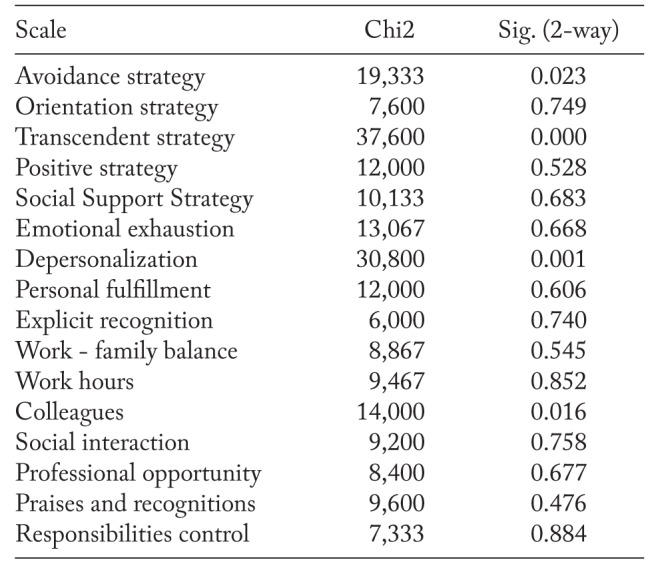
It highlighted a significance relating to avoidance and transcendent strategies, depersonalization, and colleagues justifying the analysis post hoc with the use of the Wilkoxon test for dependant paired samples (Table 2).
Table 2.
Post hoc analysis: pre/post sample group comparison through Wilkoxon test
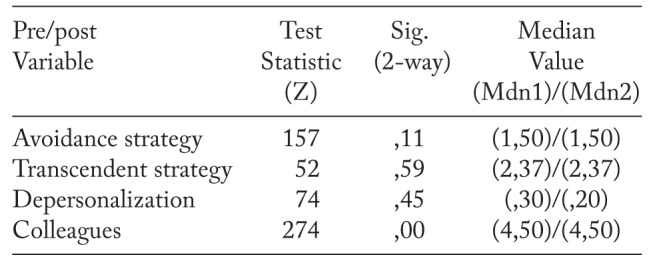
The experimental group and the control group were paired compared in each phase using the Mann–Whitney U test. From this comparison, we noticed a significant difference in the use of the avoidance strategy (U=58; p<.05) and in the colleagues relationship (U=5.6; P<.05) (Table 3 and 4).
Table 3.
Mann Whitney test between EWgroup and Cgroup in Baseline
Table 4.
Mann Whitney test between EWgroup and Cgroup in Post treatment
It is interesting the existence of a statistical significance (U= 232: p<.05) of the job satisfaction in the post intervention measured with the McCloskey Mueller Satisfaction Scale. In the control group, there is a decrease in the satisfaction concerning the work with colleagues from the PRE Phase=3 (Mdn) to the POST Phase=2.9 (Mdn). This does not occur in the experimental group that reports in the PRE Phase=3 (Mdn) and in the POST phase=3.8 (Mdn).
These questionnaires measure long-distance variation and it is for this reason that and ad-hoc questionnaire was developed to evaluate the perception of short term effectiveness of professionals. The 53,3% of the sample (N=8) consider the expressive writing very useful and 33,3% (N=5) quite useful. Only 13,3% consider the expressive writing slightly useful. A 40% of the sample (N=6) found quite solace in using the expressive writing while 33,3% (N=5) found a lot of solace. Only 20% (N=3) found a little solace. A 6,7% (N=1) found no solace.
The 46,7% of the sample (N=7) felt a little uncomfortable using the expressive writing while 33,3% (N=5) did not feel uncomfortable at all. Only 20% (N=3) felt quite uncomfortable.
In the end, the majority of the sample, the 66,7 (N=10), deeply suggests the use of the expressive writing while 26,7% (N=4) quite suggest it. Only 6.7% (N=1) slightly recommend the expressive writing.
Discussion
The Expressive Writing is a writing intervention developed to improve the psycho-physic wellness through the strengthening of the emotional and cognitive processing of events.
Through the writing of the traumatic event, the individual changes the emotional perception of the event with the re-elaboration of the emotional and cognitive reactions and the recovery of his/her own identity; this allows an improvement of the coping strategies and a reduction of the emotional distress (16).
The results of the study highlight that the avoidance and transcendent strategies are reduced from the pre-expressive writing phase to the post-expressive writing phase. This element confirms the idea that coping with a stressful or traumatic situation directly instead of avoid it reduces the physiological work of inhibition and the biological stress (17). The comparison with the trauma helps people to understand and internalize the event (17, 18). When they are organized, the events are smaller and easier to deal with. The choice of not speaking and writing about negative experiences could be harmful causing inhibition: stopping and avoiding the solution of traumas imply a continuous cohabitation with others. The same occurs when maladaptive coping strategies like avoidance are used.
The writing is a useful tool to encourage self-understanding and the comprehension of past experiences.
From the comparison within the experimental group, there is a significant difference in a dimension that identifies the burnout: the depersonalization that evaluates the cold and impersonal answer of professionals to service users. The heath workers provide treatments with difficult and stressful work condition taking into account the fact that they deal with illness, human suffering, pain, chronicity, and death continually. When the pain is not recognized, faced and developed may become chronic and cumulative with serious personal and professional consequences. The Expressive Writing represents a useful tool that allows professionals to think about experienced stressful events, deal with the feelings associated with them that may overwhelm the capabilities of professionals and avoid their emotional distance from experiences in the long term.
Consequentially, the psychological resilience of professionals affects the quality of the patient treatment.
From the comparison within the experimental group, it emerges a significant difference in the job satisfaction relating to colleagues. In the daily work, the professionals deal with many stressful events (difficulties in communication, death, responsibilities, verbal or physical abuse, long working hours) and these aspects can modify the individual job satisfaction and have consequence on the quality of assistance; it is necessary a support. The expressive writing is an efficient intervention, cheap, easy to apply and able to support healthcare workers in stressful situations. The expressive writing represents an important strategy to help healthcare workers: it allows a reduction of the maladaptive strategies, it improves the self-understanding, the past experiences acknowledge , and the professional’s capability to cope with difficulties. It has significant positive repercussions on the quality of assistance and the professional’s work quality with a reduction of the burnout risk, an implementation in the coping strategies and an increase in the work satisfaction.
In this study, the quantitative analysis allowed to highlight the presence of some important effects that an only expressive writing intervention can ensure to professionals. In fact, in the previous study led by Tonarelli (1) comparing the two groups (experimental and control), it emerged a significant difference in the working hour satisfaction. The use of the expressive writing, maybe with the effects of the emotional processing and the recognition of the positive emotions, would have had a “buffering effect” on the working hour satisfaction that has no deflection from t1 to t2 in the experimental group. Connversely, Control Group has a continuous downward trend in the values of this variable. The difference reduces and disappears in the follow up, giving the idea that later there is a nullification of the expressive writing positive effect. This result aligns with the recently data, highlighted in literature: they introduce a new methodological model that is completely new compared to the classic Pennebacker (4, 12). It suggests to vary the writing sessions (1 or 2 times) and the time distance between each session (minimum 24 hours, maximum 72) in order to obtain more stable and longer-lasting results. Furthermore, compared to the first study, it has been used a different protocol to confirm possible changes in the short term.
The limited numbers of participants makes impossible to generalize the results limiting the encountered significance. Many values showed a trend towards significance that could be completed and confirmed with a bigger sample. A further limit of the study is the use of questionnaire that measure long-term modifications and for this reason it is necessary to develop an ad-hoc questionnaire to evaluate the sort-term modifications.
References
- 1.Tonarelli A, Cosentino C, Artioli D, Borciani S, Camurri E, Colombo B, D’Errico A, Lelli L, Lodini L, Artioli G. A tool to help health workers research project on the benefits of expressive writing. Acta Biomed for health professions. 2017;88:13–21. doi: 10.23750/abm.v88i5-S.6877. [DOI] [PMC free article] [PubMed] [Google Scholar]
- 2.Houck D. Helping nurses cope with grief and compassion fatigue: an educational intervention. Clin J Oncol Nurs. 2014;18:454–458. doi: 10.1188/14.CJON.454-458. [DOI] [PubMed] [Google Scholar]
- 3.Sexton JD, Pennebaker JW, Holzmueller CG, Wu AW, Berenholtz SM, Pronovost PJ, Sexton BJ. Care for the caregiver: benefits of expressive writing for nurses in the United States. Prog Palliat Care. 2009;17:307–12. [Google Scholar]
- 4.Frattaroli J. Experimental disclosure and its moderators: A meta-analysis. Psychol Bull. 2006;132:823–65. doi: 10.1037/0033-2909.132.6.823. [DOI] [PubMed] [Google Scholar]
- 5.Smyth HE, Jones CJ, Hankins M, Field A, Theadom A, Bowskill R, Horne R, Frew AJ. The effects of expressive writing on lung function, quality of life, medication use, and symptoms in adults with asthma: A randomized controlled trial. Psychosom Med. 2015;77:429–37. doi: 10.1097/PSY.0000000000000166. [DOI] [PubMed] [Google Scholar]
- 6.Phillips C, Welcer B. Songs for the soul: a program to address a nurse’s grief. Clin J Oncol Nurs. 2017:21–145. doi: 10.1188/17.CJON.145-146. [DOI] [PubMed] [Google Scholar]
- 7.Smyth MJ, Stone AA, Hurewitz A, Kaell A. Effects of writing about stressful experiences on symptom reduction in patients with asthma or rheumatoid arthritis. Jamanetwork. 1999;281:1304–309. doi: 10.1001/jama.281.14.1304. [DOI] [PubMed] [Google Scholar]
- 8.Solano L. Franco Angeli., editor. Writing to think: the transcription of the experience between health promotion and research. 2007 [Google Scholar]
- 9.Morgan NP, Graves KD, Poggi EA, Cheson BD. Implementing an expressive writing study in a cancer clinic. The Oncologist. 2008;13:196–204. doi: 10.1634/theoncologist.2007-0147. [DOI] [PubMed] [Google Scholar]
- 10.Imrie S, Troop NA. A pilot study on the effects and feasibility of compassion-focused expressing writing in day hospice patients. Palliative and supportive care. 2012;10:115–22. doi: 10.1017/S1478951512000181. [DOI] [PubMed] [Google Scholar]
- 11.Low CA, Stanton AL, Bower JE, Gyllenhammer L. A randomized controlled trial of emotionally expressive writing for women with metastatic breast cancer. Health Psychology. 2010;29:460–66. doi: 10.1037/a0020153. [DOI] [PMC free article] [PubMed] [Google Scholar]
- 12.Milbury K, Lopez G, Spelman A, et al. Examination of moderators of expressive writing in patients with renal cell carcinoma: the role of depression and social support. Psychooncology. 2017;26:1361–8. doi: 10.1002/pon.4148. [DOI] [PMC free article] [PubMed] [Google Scholar]
- 13.Foà C, Tonarelli A, Caricati L, Fruggeri L. Validazione italiana della versione ridotta della Coping Orientation to the Problems Experienced (COPE-NVI) [Italian Validation of the short version of Coping Orientation to the Problems Experienced] Psicologia della Salute [Health Psychology] 2015;2:123–40. [Google Scholar]
- 14.Maslach C, Jackson SE, Leiter MP. Maslach Burnout Inventory manual. 3rd. Consulting Psychologists Press; 1996. [Google Scholar]
- 15.Mueller CW, McCloskey JC. Nurses’ job satisfaction: a proposed measure. Nurs Res. 1990;39(2):113–7. [PubMed] [Google Scholar]
- 16.Pennebaker JW, Beall SK. Confronting a traumatic event: Toward an understanding of inhibition and disease. J Abnorm Psychol. 1986;95(3):274–81. doi: 10.1037//0021-843x.95.3.274. [DOI] [PubMed] [Google Scholar]
- 17.Boals A, Than J, Banks B, Hataway LM, Schuettler D. Coping with stressful events: Use of cognitive words in stressful narratives and the meaning making process. J Soc Clin Psychol. 2011;30:378–403. [Google Scholar]
- 18.Pennebaker JW. Writing about emotional experiences as a therapeutic process. Psychol Sci. 1997;8:162–6. [Google Scholar]



